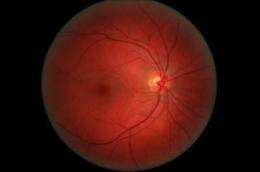More evidence on benefits of high blood pressure drugs in diabetic eye disease

Scientists in Massachusetts are reporting new evidence that certain high blood pressure drugs may be useful in preventing and treating diabetic retinopathy, the leading cause of vision loss in people with diabetes. The study, the largest to date on proteins in the retina, could lead to new ways to prevent or treat the sight-threatening disease, they say. The findings are in ACS' Journal of Proteome Research.
Edward Feener and colleagues point out that diabetic retinopathy is a common complication of diabetes, which affects millions of people worldwide. It involves damage to blood vessels in the retina, the light sensitive tissue in the back of the eye. Previous studies suggested that drugs used to treat high blood pressure, including ACE inhibitors and angiotensin receptor blockers (ARBs), may help prevent the condition.
The scientists analyzed proteins from the retinas laboratory mice with normal blood pressure and diabetes and compared them to those of non-diabetic mice. They identified 65 abnormal proteins in the diabetic mice out of more than 1,700 proteins in the study. Treatment with the ARB medication, candesartan, prevented the abnormal changes in more than 70 percent of the proteins.
More information: "Angiotensin AT1 receptor antagonism ameliorates murine retinal proteome changes induced by diabetes", pubs.acs.org/doi/full/10.1021/pr9006415
















